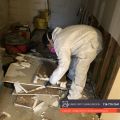White Mold in Basements, Attics, and Bathrooms: Why These Areas Are High Risk

White mold is a common yet often overlooked problem in homes, particularly in basements, attics, and bathrooms. These areas provide the perfect conditions for mold growth—high humidity, poor ventilation, and organic materials like wood, drywall, and insulation. Unlike black mold, white mold can be more difficult to detect as it blends into surfaces, but it poses similar risks to indoor air quality and structural integrity. Understanding why these areas are prone to mold growth and how to prevent it is essential for maintaining a safe and healthy home.
White mold is a fungal growth that appears powdery or fuzzy and thrives in damp, humid environments. It can grow on a variety of surfaces, including wood, drywall, carpeting, and insulation. While white mold is not a specific type of mold, it is often a sign of moisture problems and potential structural damage in a home. Common types of mold that appear white include Penicillium, Aspergillus, and Cladosporium.
Why Are Basements, Attics, and Bathrooms High-Risk Areas?
These areas of the home are particularly vulnerable to mold growth due to a combination of moisture, poor ventilation, and organic materials that provide a food source for mold spores.
1. Basements
- High Humidity Levels: Due to their location below ground, basements often retain moisture from the soil, leading to consistently high humidity.
- Poor Air Circulation: Many basements lack proper ventilation, allowing damp air to become trapped.
- Water Intrusion: Flooding, leaks, or condensation from pipes can create an ideal environment for mold.
2. Attics
- Roof Leaks: Even small leaks in a roof can introduce moisture that promotes mold growth in insulation and wood framing.
- Trapped Heat and Humidity: Poor attic ventilation can lead to condensation, particularly in colder months.
- Stored Items: Cardboard boxes, wood, and insulation provide ample food sources for mold spores.
3. Bathrooms
- Excess Moisture from Showers and Baths: Steam from hot water increases humidity, especially in bathrooms without proper exhaust fans.
- Leaky Pipes and Fixtures: Slow leaks under sinks or behind walls create hidden moisture pockets.
- Poor Ventilation: Without adequate airflow, excess moisture lingers, encouraging mold growth on tile, grout, and drywall.
Health Risks of White Mold Exposure
White mold can negatively impact indoor air quality and cause health issues, particularly for individuals with allergies, asthma, or weakened immune systems. Symptoms of mold exposure may include:
- Nasal congestion and sinus irritation
- Coughing, wheezing, and shortness of breath
- Eye and skin irritation
- Headaches and fatigue
Long-term exposure to mold in poorly ventilated areas like basements, attics, and bathrooms can contribute to chronic respiratory issues and worsen conditions such as asthma.
Preventing and Removing White Mold
Preventing mold growth is key to maintaining a healthy home environment. Here are some effective ways to reduce the risk of white mold in high-risk areas:
- Control Humidity: Keep indoor humidity levels between 30-50% using dehumidifiers or ventilation fans.
- Fix Leaks Immediately: Address roof leaks, pipe leaks, and condensation issues as soon as they appear.
- Improve Ventilation: Use exhaust fans in bathrooms, attic vents, and basement air circulators to prevent trapped moisture.
- Use Mold-Resistant Materials: When renovating, opt for mold-resistant drywall, paint, and insulation to reduce future risks.
- Regular Inspections: Check for water damage, musty odors, or discoloration on surfaces in these high-risk areas.
Bay Area Mold Pros: Expert Mold Inspection and Testing Services
If you suspect white mold in your basement, attic, or bathroom, professional mold inspection and testing are essential to determine the extent of the issue and develop an effective remediation plan. Bay Area Mold Pros offers expert mold assessment services in San Francisco, San Mateo, Santa Clara, Marin, Alameda, and Contra Costa counties. Their specialists use advanced testing methods to identify mold problems and provide solutions for removal and prevention.
For expert mold inspection and mold testing, contact Bay Area Mold Pros at (650) 762-6228 or visit Bay Area Mold Pros to schedule an inspection today.
Protect Your Home and Health
White mold can silently spread in the hidden corners of your home, leading to structural damage and potential health risks. By addressing moisture issues, improving ventilation, and scheduling professional mold inspections, you can ensure a safer and healthier indoor environment for you and your family. Don’t wait—take action today!





